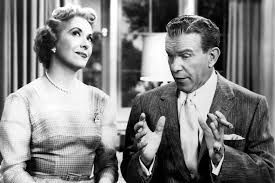Sitcoms – a 1950s perspective
When I think back on the sitcoms from the 50s, I think to myself, “What’s a sitcom?” After all, I was born in 1950 and since the 50s comprise only 10 years of my life, my black and white television world consisted mostly of cartoons, superheroes, and westerns, with an occasional Wonderama, Mickey Mouse Club, and Captain Kangaroo thrown in.
These were not sitcoms. By definition: A Sitcom is a television series that involves a continuing cast of characters in a succession of comedic circumstances: situation comedy.
A number of sitcoms came out in the early 50s, to which I only became aware of as I grew older and they were broadcast as reruns. Though it might be debatable to define the following shows as sitcoms, due to the fact that each episode was a different story, even though they involved the same characters, I would have to include The Three Stooges and Abbott and Costello as shows that resonated with me. They gave me comfort because they were funny. In each case, at least one of the male characters was not the brightest bulb in the bunch or all of them in the case of the three stooges. I liked that. Their actions were like when I write and play with words – a twist of meaning, an unexpected faux pas, a goofy character. Probably nowadays some of those types of programs would be considered politically incorrect.
But don’t think that all of the sitcoms made fun of only ditzy men. Two of my favorites were the “Burns and Allen Show” and “Topper”.
 I liked how George Burns would talk to the audience as if he were letting us onto something that the other characters didn’t know he knew. In fact, I find myself doing some of the same things in my fictional writing when I break the 4th wall and explain things to the audience. And of course, Gracie was the ditz. I loved the way she messed up words.
I liked how George Burns would talk to the audience as if he were letting us onto something that the other characters didn’t know he knew. In fact, I find myself doing some of the same things in my fictional writing when I break the 4th wall and explain things to the audience. And of course, Gracie was the ditz. I loved the way she messed up words.
Now Topper was different. Cosmo Topper (played by Leo G. Caroll) was a banker who lived with a ditzy wife and had a kind of ditzy housekeeper. The fun part about this  show was that the house they lived in was also inhabited by George and Marion Kerby and their dog Neil, who were the previous owners of the house and had been killed in an avalanche. Topper is the only one who can hear and see these ghosts. Therein lies the setting for the show as these socialite ghosts try to improve Topper’s quality of life. The special effects for the time period were pretty impressive.
show was that the house they lived in was also inhabited by George and Marion Kerby and their dog Neil, who were the previous owners of the house and had been killed in an avalanche. Topper is the only one who can hear and see these ghosts. Therein lies the setting for the show as these socialite ghosts try to improve Topper’s quality of life. The special effects for the time period were pretty impressive.
I was never a fan of horror shows, but these ghosts, combined with the silliness of the characters, was definitely my style. To write this piece I watched one of the original shows and though dated, it was still a pretty funny show. I’m guessing that shows like these not only gave me comfort then but certainly have impacted the ideas that I come up with for my writing now, especially when I only have 20 minutes to write. They certainly are a lot better than some of the things that are on TV now. In my humble opinion.

I have never seen an entire topper episode but have seen plentyof Burns and Allen. I really enjoyed your post.